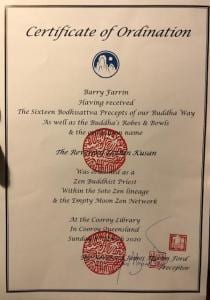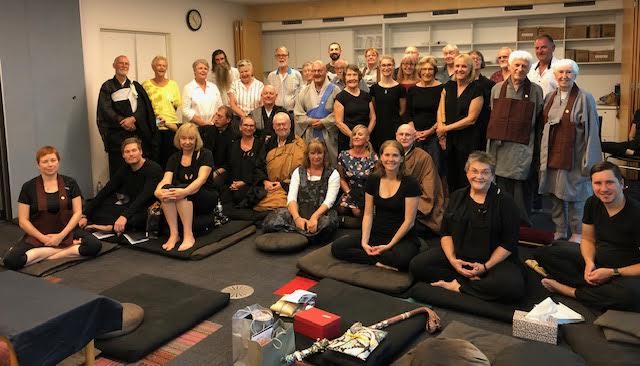On Wednesday last, Jan & I climbed aboard a Virgin Australia plane at LAX and spent the next fourteen hours winging our way to Brisbane, Australia. Perhaps because of health concerns, maybe just the luck of the draw, the flight was light and we were able to find two rows of seats where we could (very uncomfortably) lay ourselves down for a fitful night’s sleep.
When we arrived we were picked up by Marie and Barry Farrin. They provided us with a lovely if lightning fast tour of Brisbane. A bright city, that sure looks prosperous and in some areas even sleek. We loved, loved, a ride on the CityCat ferry down the Brisbane river a bit and back.
Next we swung by Gregg Howard‘s home. Gregg has been described as the dean of the Brisbane Zen community. There he made us a lovely lunch and made sure we were welcomed fully Australian style. We also chatted about the larger dharma family discovering the many people we know in common, many important in our spiritual journeys.
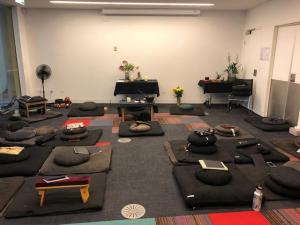
From there the four of us climbed into the car and took the not quite two hour drive up the coast to Doonan. There we arrived at the Forest Way Zen, which is both the Doonan Zendo and their home.
Over the next couple of days we were squired around, saw the most astonishingly beautiful coast, sat a one-day zazenkai, where I was invited to speak, sighted a family of kangaroos, and generally enjoyed ourselves. Only slightly gobsmacked along the way by the rather dramatic time changes between LA & Eastern Australia.
But we were really there for an ordination.
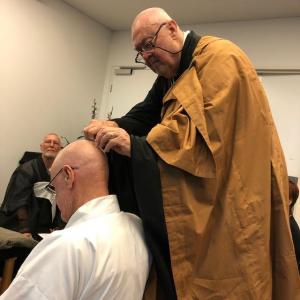
And that’s what I want to write about here.
Marie and Barry are both long time students of the dharma and specifically of Zen. Barry was authorized as an assistant teacher in 2004 and received full dharma transmission from Subhana Barzaghi in 2015. Through Subhana, Barry is a close dharma relative of mine. Our shared root teacher is Robert Aitken.
What led to this trip is the fact that in addition to being a koan teacher within Aitken Roshi’s lineage, I am also a Soto Zen priest.
My own path is messy, apparently not unlike a lot of others of my generation. After beginning practice at the Berkeley Zendo (now Center) branch of the San Francisco Zen Center, at her arrival I became a disciple of Houn Jiyu Kennett. I quickly ordained with her. And just shy of two years later, in 1971, received denkai and denbo transmission. However, not long after that I left. The reasons are complex. After a period of wandering (see above, the messy thing), I became a student of John Tarrant. After about fifteen years I was authorized as an assistant teacher, and then in 2005, I received Inka, full authorization from John Tarrant as an independent teacher of koan Zen.
So, while ordained, the bulk of my Zen training was with a lay teacher.
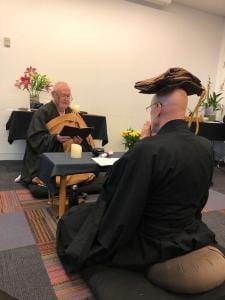
This has been critical in my evolving sense of how best to live and thrive within our emerging Western Zen project. (I’ve been asking Australians about whether they actually consider themselves Western. And I’ve heard various views. The majority eventually landing somewhere, if uncomfortably, within the “Western” construct.)
Over the past decade and a half, roughly, I’ve been trying to find the best way, not only to serve, but to live within the Zen way as a Westerner within a Western cultural context. And with it that ordination thing has been a central part of the questions continuing to bubble for me.
I’ve come to feel a number of conclusions. All are, of course, provisional. Some more so than others.
First, the primacy of the project, one could say, the whole of the project of Zen is awakening. And it knows neither monk, nor priest, nor lay person, nor males nor females, nor anyone anywhere upon the great spectrum of our human sexualities. It isn’t about being smart or educated. It isn’t even too much about mental health.
Zen is about awakening. That is finding our true nature beyond the twin traps of “self” and “other,” beyond the traps of “form” and “emptiness.”
And this has been and remains the great calling of my life. I cannot say how grateful I am for the discovery of this way.
And, fully, it is my way. I belong to it in a manner I can only approach describing.
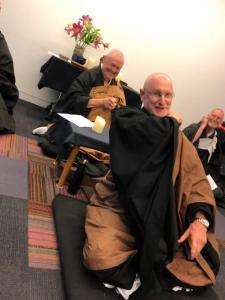
Through a series of interesting accidents a major part of Zen in the West has been the rise of lay or, perhaps better, householder Zen. And the truth be told there is an uneasiness between the priestly and monastic led sanghas and householder sanghas. Lots of high minded rhetoric, but in practice many, possibly the larger majority of the ordained do not in fact, do not in deed, act out of a sense of the full equality of ordained and lay practice. Some of the ordained communities won’t even allow full authorization of householder teachers.
I’ve been struggling with this even as I’ve been throwing myself into re-learning and sometimes flat out learning the beautiful ordained way within Japanese and Japanese-derived Soto Zen. It touches my heart. And my brain. I have thought about it a lot and see that ordained life in the West has three aspects, l two traditional and one emerging. The first of the two is the call of a community of mutuality and practice. It is a vowed life. Functionally it somewhat resembles Christian third orders. Although not precisely. The second is that actual priestly, sacerdotal life. Here priestly disciplines include rituals meant to mediate between and among the worlds. It is magical and mysterious. The third is seeing this ordained life within the context of ministry as it is generally understood in the West. Here it is about service and a certain commitment to the communities of the Zen heart.
This has been my calling within the larger context of Zen practice. It remains so.
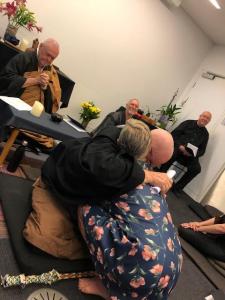
But I’ve felt the strains and have tried to find ways to serve that reframe the householder/priestly divides.
What I’ve come to at this moment is naming the project I am involved with at the Empty Moon “centers” the project around householders. Our front page reads:
“We are a Householder Zen community.. We are united by a common practice. We offer meditation in the Zen style, as well as koan introspection—the path of words and freedom within the constraints of our human condition. We have evening sits, longer one-day sits, study sessions, and multiple-day long intensive retreats. Also join us for chanting services, ceremonies, talks, and classes.
While we are centered in Householder practice, we also transmit the Soto Zen priestly line for those called into that form of practice.”
Can we center householder practice and still have priests with that community? Will this work? Can it work? I don’t know.
But, then, for those of us on the Zen way not knowing is, as our teachers say, “most intimate.”
Okay. With that as background, Barry.
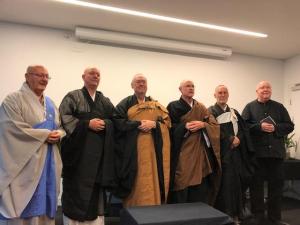
Barry has trained entirely as a householder. Although if you visit the Doonan Zendo you’ll see there’s a fuzzy boundary between the Zendo and the house. Throughout are those small signs, like directions in the toilet, and what is usable and not in the refrigerator, that sings out Zen center. And, it is Marie and Barry’s home.
And the ancient calls of service and practice that are priestly has whispered in his ear for some years.
He contacted me and we began a conversation that has continued for a bit more than a year. During this time he has attempted to learn the basic liturgical patterns of Soto Zen priest. He has done monastic training, and residential training, but not the formal ango of the Japanese and Japanese-derived Soto Zen communities. So, he’ll never, at least not in their current configurations, be eligible to join the Soto Zen Buddhist Association. (Although he is a member of the American Zen Teachers Association.)
But ordination is allowing him to explore his own variation on that project that centers practice within the Householder community, but allows for priests.
And, on Sunday (Australian timezones), the 8th of March, 2020, in a large room offered by the library and set up as a Zen hall, and before about forty witnesses and assisted by two householder teachers and two priests, one Soto and the other Rinzai, Gregg Howard, Greg Bantick, Eric Batten, & Peter Hart, I ordained Barry Kusan Farrin a Zen priest within the Soto steam.
Our sanghas will maintain an informal association. And, well, who knows where it will go?
As Dogen did not say, but almost did, and certainly could have…
One continuous mistake.
Endless bows from Down Under…


